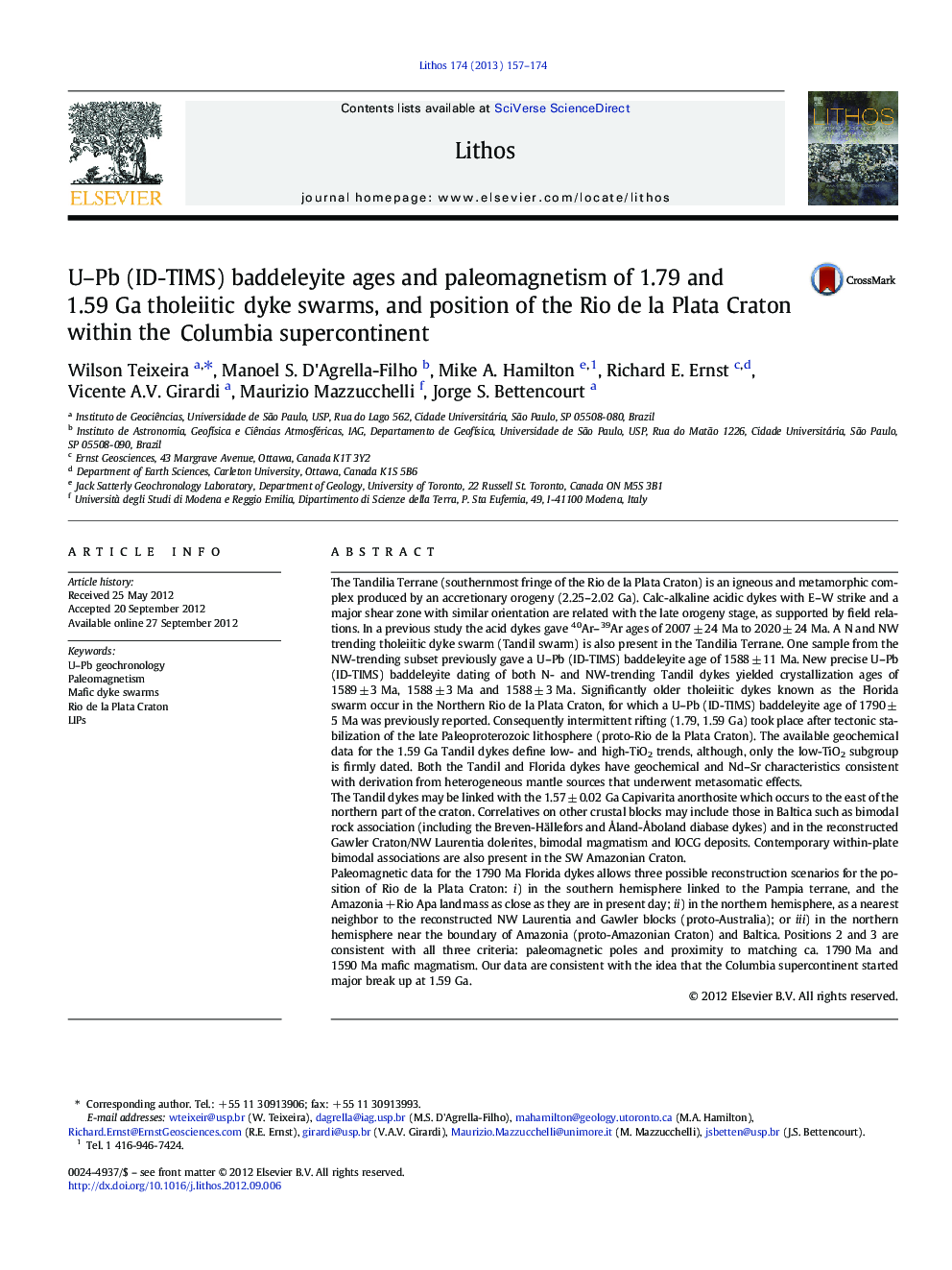| کد مقاله | کد نشریه | سال انتشار | مقاله انگلیسی | نسخه تمام متن |
|---|---|---|---|---|
| 4716186 | 1638690 | 2013 | 18 صفحه PDF | دانلود رایگان |

The Tandilia Terrane (southernmost fringe of the Rio de la Plata Craton) is an igneous and metamorphic complex produced by an accretionary orogeny (2.25–2.02 Ga). Calc-alkaline acidic dykes with E–W strike and a major shear zone with similar orientation are related with the late orogeny stage, as supported by field relations. In a previous study the acid dykes gave 40Ar–39Ar ages of 2007 ± 24 Ma to 2020 ± 24 Ma. A N and NW trending tholeiitic dyke swarm (Tandil swarm) is also present in the Tandilia Terrane. One sample from the NW-trending subset previously gave a U–Pb (ID-TIMS) baddeleyite age of 1588 ± 11 Ma. New precise U–Pb (ID-TIMS) baddeleyite dating of both N- and NW-trending Tandil dykes yielded crystallization ages of 1589 ± 3 Ma, 1588 ± 3 Ma and 1588 ± 3 Ma. Significantly older tholeiitic dykes known as the Florida swarm occur in the Northern Rio de la Plata Craton, for which a U–Pb (ID-TIMS) baddeleyite age of 1790 ± 5 Ma was previously reported. Consequently intermittent rifting (1.79, 1.59 Ga) took place after tectonic stabilization of the late Paleoproterozoic lithosphere (proto-Rio de la Plata Craton). The available geochemical data for the 1.59 Ga Tandil dykes define low- and high-TiO2 trends, although, only the low-TiO2 subgroup is firmly dated. Both the Tandil and Florida dykes have geochemical and Nd–Sr characteristics consistent with derivation from heterogeneous mantle sources that underwent metasomatic effects.The Tandil dykes may be linked with the 1.57 ± 0.02 Ga Capivarita anorthosite which occurs to the east of the northern part of the craton. Correlatives on other crustal blocks may include those in Baltica such as bimodal rock association (including the Breven-Hällefors and Åland-Åboland diabase dykes) and in the reconstructed Gawler Craton/NW Laurentia dolerites, bimodal magmatism and IOCG deposits. Contemporary within-plate bimodal associations are also present in the SW Amazonian Craton.Paleomagnetic data for the 1790 Ma Florida dykes allows three possible reconstruction scenarios for the position of Rio de la Plata Craton: i) in the southern hemisphere linked to the Pampia terrane, and the Amazonia + Rio Apa landmass as close as they are in present day; ii) in the northern hemisphere, as a nearest neighbor to the reconstructed NW Laurentia and Gawler blocks (proto-Australia); or iii) in the northern hemisphere near the boundary of Amazonia (proto-Amazonian Craton) and Baltica. Positions 2 and 3 are consistent with all three criteria: paleomagnetic poles and proximity to matching ca. 1790 Ma and 1590 Ma mafic magmatism. Our data are consistent with the idea that the Columbia supercontinent started major break up at 1.59 Ga.
► Rio de la Plata Craton hosts the Florida (1.79 Ga) and Tandil (1.59 Ga) dyke swarms.
► We present a 1.79 Ga paleomagnetic pole for the Florida tholeiitic dyke swarm.
► We report precise U–Pb baddeleyite ages for the Tandil tholeiitic dyke swarm.
► There is a link with bimodal magmatism and fault related basins in space and time.
► We allow three possible positions of this Craton within the Columbia supercontinent.
Journal: Lithos - Volume 174, 1 August 2013, Pages 157–174